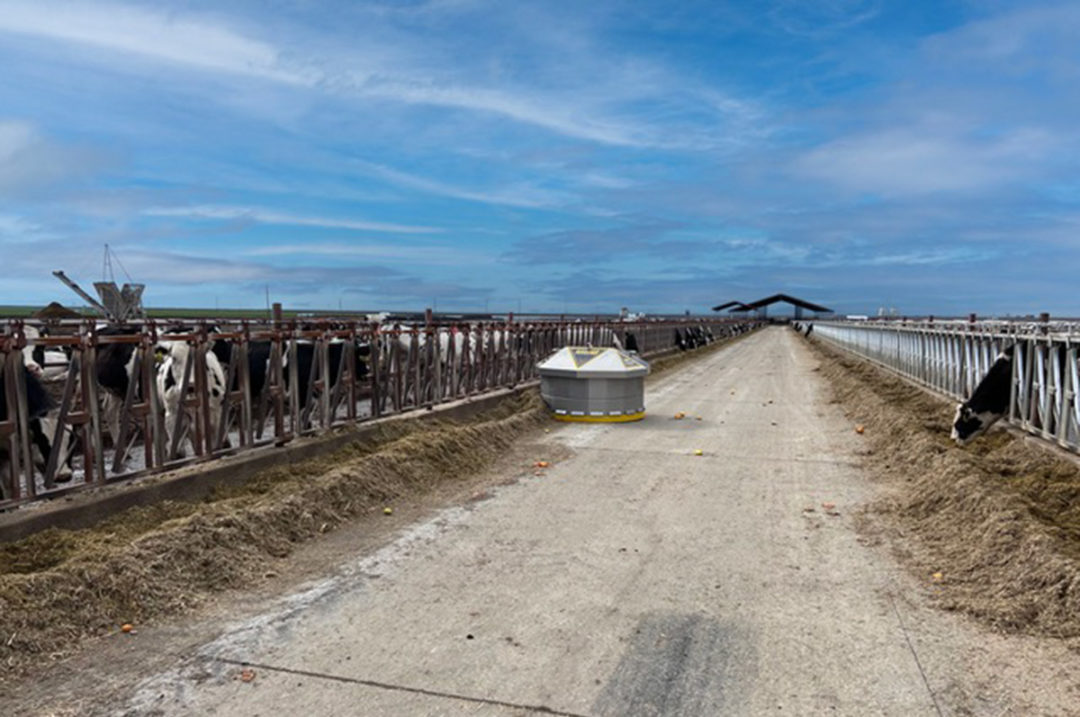To read this article in French, click here.
In the ever-evolving world of agriculture, robotic technology has found its way into various aspects of farming, including dairy production. Automated feed pushing systems have emerged as a revolutionary solution for improving feed management in dairy farms. These advanced systems offer several benefits that positively impact the well-being and productivity of cows.
This article delves into the advantages of automated feed pushing, focusing on the consistency and reduction of feed refusals, increased butterfat content, minimized sorting behavior and enhanced performance of more timid cows.
Consistency and reduced feed refusals
Automated feed pushing ensures a consistent and timely distribution of feed to cows, eliminating the inconsistencies that can occur with manual feeding methods. Traditional feeding practices may inadvertently result in uneven feed distribution, leading to some cows receiving more feed than others. This inconsistency often leads to feed refusals, where cows selectively consume only certain components, compromising their nutritional intake. By implementing automated feed pushing systems, dairy farmers can maintain a constant supply of fresh feed throughout the day, ensuring that all cows have equal access to a balanced diet. As a result, feed refusals are significantly reduced, promoting improved nutrition and overall health.
Increased butterfat content
An additional advantage of automated feed pushing is its positive impact on butterfat content in milk. Consistent feed distribution and access to a well-balanced diet are key factors in achieving optimal milk quality. Automated systems ensure that cows receive fresh, high-quality feed at regular intervals, which can positively influence butterfat production. By maintaining a steady supply of feed and minimizing feed refusals, automated feed pushing helps promote consistent butterfat content in milk, which is highly valued in the dairy industry.
Minimized sorting
Cows commonly exhibit sorting behavior when presented with a mixed ration, selectively consuming certain components while leaving others behind. This sorting behavior can lead to imbalances in nutrition and compromise cow health. Automated feed pushing systems play a crucial role in minimizing sorting behavior. By consistently distributing feed, these systems discourage cows from picking and choosing their preferred components. As a result, cows consume the entire ration, leading to a more balanced and nutritionally complete diet. Minimized sorting ensures that cows receive the necessary nutrients, contributing to their overall well-being.
Improved performance for timid cows
Timid or shy cows often face challenges in competitive feeding environments, where more dominant cows may monopolize access to feed. Automated feed pushing systems create a more equitable feeding environment by ensuring that all cows have equal opportunity to access fresh feed. This equal distribution reduces competition and stress, allowing timid cows to comfortably access the feed they need. As a result, these cows experience improved feed intake, weight gain and overall performance. Automated feed pushing systems offer a solution that fosters the well-being and productivity of all cows, regardless of their temperament.
Conclusion
The incorporation of automated feed pushing systems in dairy farms brings numerous advantages to the management of cow feeding. Consistency and reduced feed refusals promote better nutrition and overall cow health. Additionally, the reliable distribution of feed leads to increased butterfat content in milk, enhancing its value. Minimized sorting behavior ensures cows receive a balanced diet, while timid cows benefit from improved access to feed and enhanced performance.
As technology continues to advance, automated feed pushing systems will undoubtedly play a crucial role in optimizing dairy farming practices, allowing for the well-being and productivity of cows to reach their full potential.











